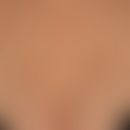Synonym(s)
DefinitionThis section has been translated automatically.
Lauryl glucoside (lauryl glucoside), a white solid, is a non-ionic surfactant derived from plant ingredients, which is well tolerated by the skin and has the molecular formula: C18H36O60. Like coco glucosides or decyl glucosides, lauryl glucoside is a sugar surfactant (group of alcylpolyglucosides). The substance is soluble in water and methanol. Chemically, lauryl glucosides can be obtained by reacting lauryl alcohol with glucose. At temperatures below 38 ° lauryl glucoside has the density of a paste.
Lauryl glucoside has excellent dermatological compatibility, good conditioning properties and can increase the viscosity of detergents. The substance is used as a base or co-surfactant up to 20% in a preparation. As a nonionic surfactant it is compatible with other surfactants. Its foaming power is less pronounced, however. Lauryl Glucoside does not require any additional preservation.
Note(s)This section has been translated automatically.
Lauryl Glucoside is suitable for natural cosmetic formulations.




